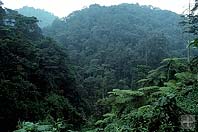Effectiveness of Conservation Efforts
2011 Rain Forest Rescue Report
There are two schools of thought about protecting rain forests.
One is to create preserves (“protected areas”) where no human occupation is allowed, and visits can only be for scientific study or passive recreation such as wildlife viewing. The other approach is to maintain forest cover through community control of forests that are managed for sustainable production of various commodities.
Although recognizing that both kinds of protective policies have their place depending on circumstances, the Arbor Day Foundation has primarily supported the latter method for many years. For example, Arbor Day shade-grown coffee helps promote farming practices that retain forest cover and wildlife habitat and reduce the need for chemical inputs. Also, Rain Forest Rescue promotes community education that can lead to local rules for managing the forest sustainably and for multiple purposes.
Now there is scientific validation of this model thanks to a study by L. Porter-Bolland and colleagues. It is titled Community Managed Forests and Forest Protected Areas: An Assessment of their Conservation Effectiveness Across the Tropics. The full article may be found in the journal, “Forest Ecology and Management.”
The report is based on the authors’ examination of peer-reviewed studies of 40 protected areas and 33 community-managed forests in 16 Latin American countries, two countries in Africa and three in Asia. They then compared deforestation in these areas. They found that while the protected areas lost an average of 1.46 percent of their forest cover per year, community-managed forests lost only .24 percent per year. An important reason for the latter is that despite development pressures, communities that have working rules for managing forest areas are in a better position to protect the resources.
Reasons cited in the report for the loss of tree cover were:
- Road construction
- Coffee plantations
- Timber exploitation
- Population growth
- Agricultural expansion
- Cattle ranching
In a summary of the study by the Center for International Forestry, Manuel Guariguata, one of the report authors, says, “Our findings suggest that a forest put away behind a fence and designated ‘protected’ doesn’t necessarily guarantee that canopy cover will be maintained over the long term… When done properly, the benefits of community-based management can be seen over the long term, leading to greater conservation participation, reduced poverty, increased economic productivity and the protection of many forest species.”
Save 2,500 square feet of rain forest today
Accomplishments in Guatemala 2011 Rain Forest Rescue Report HomeOr read and print the full report on one page.


